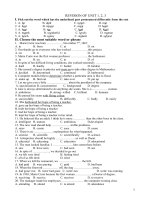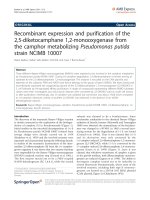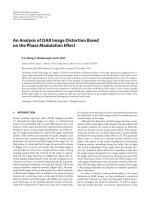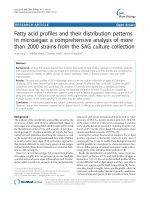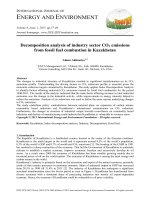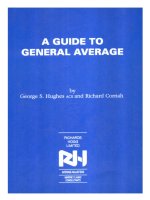NN AN ANALYSIS OF a SUGGESTED TRANSLATION OF CHAPTERS 1, 2 3 FROM THE BOOK “LIVING IN THE LIGHT a GUIDE TO PERSONAL TRANSFORMATION” BY SHATKI GAWAIN AND LAUREL KING, 1998
Bạn đang xem bản rút gọn của tài liệu. Xem và tải ngay bản đầy đủ của tài liệu tại đây (350.04 KB, 75 trang )
MINISTRY OF EDUCATION AND TRAINING
DUY TAN UNIVERSITY
FACULTY OF ENGLISH
GRADUATION THESIS
VU KHANH NHI
AN ANALYSIS OF A SUGGESTED TRANSLATION OF
CHAPTERS 1, 2 & 3 FROM THE BOOK “LIVING IN THE
LIGHT_ A GUIDE TO PERSONAL TRANSFORMATION” BY
SHATKI GAWAIN AND LAUREL KING, 1998
Major: English for Translation and Interpretation
SUPERVISOR: BUI THI KIM PHUNG, M.A
STUDENT
: VU KHANH NHI
CLASS
: K23NAB1
STUDENT CODE
: 2320315578
DA NANG, 2021
GRADUATION THESIS
Supervisor: Bui Thi Kim Phung, M.A.
ACKNOWLEDGEMENTS
During the time I study at Duy Tan University, I have been
enthusiastically taught by the teachers, they have imparted me very useful
knowledge that I find would really useful for my career in the future. I would
like to sincerely thank the school administrators and the teachers of the
Foreign Language Department for their dedication in guiding me to complete
the courses well.
In particular, I would like to send to Ms. Bui Thi Kim Phung – who has
wholeheartedly guided and helped me complete this graduation paper, my
deepest thanks. I wish all the teachers more health and luck to strive for more
high achievements in teaching. I wish Duy Tan University will forever be the
belief, a solid foundation for many generations of students with their learning
journey.
Besides, I would like to thank my family and friends for supporting me
throughout the process of completing this graduation paper.
Given the limited time and experience, the shortcomings of this
graduation paper cannot be avoided. I look forward to receiving the guidance
and opinions of the teachers so that I can supplement, learn from experience
and better serve the practical work later.
Thank you so much!
Sincerely
Student
Vu Khanh Nhi
Student: VU KHANH NHI
Code: K23.701
GRADUATION THESIS
Supervisor: Bui Thi Kim Phung, M.A.
STATEMENT OF AUTHORSHIP
Except where reference is made in the text of the thesis, this thesis
contains no material published elsewhere or extracted in the whole or in part
from a thesis by which I have qualified for or been awarded another degree
or diploma.
No other person’s work has been used without due acknowledgement in
the thesis.
This thesis has not been submitted for award of any degree or diploma in
any other tertiary institution.
Da- nang, December 2021
Vu Khanh Nhi
Student: VU KHANH NHI
Code: K23.701
GRADUATION THESIS
Supervisor: Bui Thi Kim Phung, M.A.
ABSTRACT
This paper is a suggested translation of Chapters 1, 2, and 3 of Shatki
Gawain and Laurel King's book "Living in the Light: A Guide to Personal
Transformation." In addition, in this book, I also examine some complex
problems such as vocabularies and structures. As a result, I explain some of
the difficulties and solutions I faced when translating at the conclusion of this
graduation paper.
Student: VU KHANH NHI
Code: K23.701
GRADUATION THESIS
Supervisor: Bui Thi Kim Phung, M.A.
ABBREVIATIONS
SL
: source language
TL
: target language
S
: Subject
V
: Verb
O
: Object
A
: Adverbial
C
: Complement
Adv
: Adverb
Living in the light
: Living in the light_a guide to personal
transformation
Student: VU KHANH NHI
Code: K23.701
GRADUATION THESIS
Supervisor: Bui Thi Kim Phung, M.A.
TABLE OF CONTENTS
ACKNOWLEDGEMENTS.....................................................................................................i
STATEMENT OF AUTHORSHIP........................................................................................ii
ABSTRACT.............................................................................................................................iii
ABBREVIATIONS.................................................................................................................iv
CHAPTER 1: INTRODUCTION..........................................................................................1
1.1. Rationale....................................................................................................................1
1.2. Aims and Objectives..................................................................................................1
1.2.1. Aims.....................................................................................................................1
1.2.2. Objectives............................................................................................................1
1.3. Scope of the Study.....................................................................................................2
1.3.1. Text Features.......................................................................................................2
1.3.2. Text Length.........................................................................................................2
1.3.3. Text Organization...............................................................................................2
1.3.4. Text Source..........................................................................................................2
1.4. Methods of the Study................................................................................................3
CHAPTER 2: THEORETICAL BACKGROUND.............................................................4
2.1. Translation Theory....................................................................................................4
2.1.1. Definition of Translation....................................................................................4
2.1.2. Types of Categories............................................................................................4
2.1.2.1. Full vs Partial Translation..........................................................................4
2.1.2.2. Total vs Restricted Translation..................................................................5
2.1.2.3. Phonological Translation............................................................................6
2.1.2.4. Graphological Translation..........................................................................6
2.1.2.5. Transliteration.............................................................................................6
2.1.2.6. Free, Literal, and Word-for-word Translation.........................................6
2.2. Principles and Methods of Translation...................................................................7
2.2.1. Principles.............................................................................................................7
2.2.1.1. Meaning........................................................................................................7
2.2.1.2. Form.............................................................................................................7
2.2.1.3. Register.........................................................................................................7
Student: VU KHANH NHI
Code: K23.701
GRADUATION THESIS
Supervisor: Bui Thi Kim Phung, M.A.
2.2.1.4. Source language influence..........................................................................7
2.2.1.5. Idiom.............................................................................................................8
2.2.1.6. Style and Clarity..........................................................................................8
2.2.2.
Methods of Translation..................................................................................8
2.2.2.1. Word-for-word Translation........................................................................8
2.2.2.2. Literal Translation......................................................................................8
2.2.2.3. Faithful Translation....................................................................................9
2.2.2.4. Semantic Translation..................................................................................9
2.2.2.5. Adaptation..................................................................................................10
2.2.2.6. Idiomatic Translation................................................................................10
2.2.2.7. Communicative Translation.....................................................................10
2.2.2.8. Free translation..........................................................................................11
CHAPTER 3: SUGGESTED TRANSLATION.................................................................12
ENGLISH VERSION....................................................................................................12
VIETNAMESE VERSION............................................................................................12
CHAPTER 4: ANALYSIS.....................................................................................................42
4.1. Vocabulary...............................................................................................................42
4.1.1. Multi - Meaning Words....................................................................................42
4.1.2. Phrasal verbs....................................................................................................47
4.1.3 Idioms.................................................................................................................49
4.1.4. Words and phrases with no appropriate meaning in dictionary.................50
4.2. Structures.................................................................................................................51
4.2.1. Compound Sentences.......................................................................................51
4.2.2. Complex Sentences...........................................................................................52
4.2.2.1. Complex sentences with Adverbial Clause..............................................54
4.2.2.2. Complex sentences with relative clause...................................................55
4.2.2.3. Complex sentences with Noun Clause.....................................................57
4.2.3. Compound-complex Sentences........................................................................58
4.2.4. Passive Voice.....................................................................................................61
4.3. Empty Subject.........................................................................................................62
4.4. Imperative sentence.................................................................................................63
CHAPTER 5. DIFFICULTIES AND SOLUTIONS.........................................................64
Student: VU KHANH NHI
Code: K23.701
GRADUATION THESIS
Supervisor: Bui Thi Kim Phung, M.A.
5.1. Difficulties................................................................................................................64
5.1.1. Vocabulary:.......................................................................................................64
5.1.2. Structures:.........................................................................................................64
5.2. Solutions...................................................................................................................65
5.2.1. Vocabulary:.......................................................................................................65
5.2.2. Structures:.........................................................................................................65
CHAPTER 6: CONCLUSIONS AND SUGGESTIONS..................................................66
6.1. Conclusions..............................................................................................................66
6.2. Suggestions...............................................................................................................66
REFERENCES.......................................................................................................................67
SUPERVISOR’S COMMENTS...........................................................................................69
Student: VU KHANH NHI
Code: K23.701
GRADUATION THESIS
Supervisor: Bui Thi Kim Phung, M.A.
CHAPTER 1: INTRODUCTION
1.1.Rationale
At this age, I will inevitably go through periods of feeling sad,
negative, and unmotivated. In addition, I have always felt that within me there
is an abundant source of energy that can improve my spirit and attitude
towards life, but I have not been able to discover it. I have always longed to
find deeper meaning and purpose in my life, but I didn't know how until I
found this book. That's also the reason why I decided to translate this book.
In this book, Shatki Gawain gently shows you the path to getting in
touch with your intuition and acting on it. Learning to trust the creativity that
flows through the universe, the source of intuition, can transform your life in
many ways by: creating new pattern for successful relationships, discovering
the energy of the universe within your sexual being, finding the work that you
love, and blurring the line between work and play, nurturing your spiritual
power, overcoming the negative thinking that limits your finances, health, and
happiness.
1.2. Aims and Objectives
1.2.1. Aims
- To get a thorough grasp of theoretical translation and to practice using
specific English in a flexible, imaginative, and precise manner.
- To display my translation and document analysis abilities.
1.2.2. Objectives
- To translate documents fluently and accurately.
- To study difficult words, phrases, idioms, and structures, etc.
- To improve my translation abilities.
1.3. Scope of the Study
The book of Shatki Gawain shows the way to greater aliveness and
creativity and to a transformation of the world around you. However, because
Student: VU KHANH NHI
Code: K23.701
GRADUATION THESIS
Supervisor: Bui Thi Kim Phung, M.A.
of time limitation, this graduation paper only focuses on chapters 1,2 & 3 with
4,004 words.
1.3.1. Text Features
- The author of this book is Shatki Gawain. Gawain's best known book is
Creative Visualization: Use the Power of Your Imagination to Create What
You Want in Life (1978). It has been a bestselling book for nearly 40 years. In
addition, Laurel King was the one who helped Gawain in the writing process
and came up with ideas for the original edition of the book.
- The first, second, and third chapters of "Living in the Light" are the
ones I chose to translate. The book is divided into 23 chapters that discuss
ways to improve our ability to sense things, develop life skills, and the art of
living.
1.3.2. Text Length
The book includes 23 chapters, but the time is limited so I have
translated only 3 chapters with 4,004 words in length.
1.3.3. Text Organization
The book includes 23 chapters, because of limitation of time, I have
translated only 3 chapters.
- Chapter 1: A New Way of Life.
- Chapter 2: The Higher Power Within Us
- Chapter 3: Intuition
1.3.4. Text Source
/>1.4. Methods of the Study
There are many methods of scientific research, such as: data collection
methods, qualitative methods, quantitative methods, experimental methods,
analytical and synthesis methods, inductive and interpretive methods,
historical and logical methods, etc. In this graduate thesis, I have focused
considerably on mixed methodologies, including qualitative methods,
Student: VU KHANH NHI
Code: K23.701
GRADUATION THESIS
Supervisor: Bui Thi Kim Phung, M.A.
quantitative methods, analytical and synthetic methods. . Specifically, these
methods help to divide the research object into parts, aspects and elements
that are simpler to analyze and discover the nature, properties, and laws of
each receiving part of the object, research object from which to better
understand the research object, step by step dissecting each piece of data to
see more clearly the nature of the research object and phenomenon.
Student: VU KHANH NHI
Code: K23.701
GRADUATION THESIS
Supervisor: Bui Thi Kim Phung, M.A.
CHAPTER 2: THEORETICAL BACKGROUND
2.1. Translation Theory
2.1.1. Definition of Translation
There are several definitions of translation depending on people’s points
of view about languages and translation, but we can simply understand that
translation is the process of clearly presenting the relationship between at
least two languages: source language (SL) and target language (TL).
Some famous linguists have given various definitions of translation as
follow:
“Translation is the replacement of textual material in one language
(SL) by equivalent textual material in another language (TL).”
(J.C. Catford, 1965)
“Translation is a process of rendering the meaning of a text into another
language in the way that the author intended the text.”
(Peter Newmark, 1988)
“Translation is the process of conveying messages across linguistic and
cultural barriers.”
(Tudor Ian, Dr, 1965)
These definitions show that translation is a difficult process that requires
both academic and practical understanding from translators.
2.1.2. Types of Categories
There are some types of categories of translation defined in terms of
extent, levels, and ranks of translation.
2.1.2.1. Full vs Partial Translation
(i) In a full translation, the entire text is submitted to the translation
process: that is, the TL material replaces every part of the SL.
Student: VU KHANH NHI
Code: K23.701
GRADUATION THESIS
Supervisor: Bui Thi Kim Phung, M.A.
Examples: For many of us, the old world was based on an external focus
- having lost our fundamental spiritual connection, we have believed that the
material world is the only reality
Đối với nhiều người trong chúng ta, thế giới cũ tập trung vào
hình thức bên ngoài - khi mất đi mối liên hệ cơ bản với tâm hồn, chúng ta tin
rằng thế giới vật chất là thực tại duy nhất.
(ii) In a partial translation, some part or parts of the SL are left
untranslated: they are simply transferred to and incorporated into the TL. In
literary translation, it is not uncommon for some SL lexical items to be
translated this way either because they are regarded as ‘untranslatable’ or for
the deliberate purpose of introducing ‘local colour’ to the TL.
Examples: Bánh Mì là một món ăn sáng điển hình của Việt Nam.
“Banh Mi” is a typical Vietnamese breakfast.
2.1.2.2. Total vs Restricted Translation
(i) Total translation is usually meant by ‘translation’ most of the time;
that is, translation in which all levels of the SL text are replaced by TL
material. Strictly speaking, “total” translation is a misleading term, since,
though total replacement is involved, it is not the replacement by equivalents
at all levels.
Example: There is a legend about a bird which sings just once in its life,
more sweetly than any other creature on the face of the earth.
Có một truyền thuyết về một con chim chỉ hót một lần trong đời,
nhưng nó hót ngọt ngào hơn bất cứ loại chim nào trên trái đất này.
(ii) Restricted translation is the replacement of SL textual material by
equivalent TL textual material, at only one level, that is translation performed
only at the phonological or at the graphological level, or at only one of the
two levels of grammar and lexis.
Student: VU KHANH NHI
Code: K23.701
GRADUATION THESIS
Supervisor: Bui Thi Kim Phung, M.A.
Example: Genève Giơ - ne - vơ
2.1.2.3. Phonological Translation
According to Nguyen Manh Quang, M.A. [4, p6], in this translation, the
main thing is SL phonology is replaced with equivalent TL one, but there are
hardly other important replacements. In phonological translation, sometimes
grammatical or lexical changes may result accidentally.
Example: Radio Ra – đi - ô
2.1.2.4. Graphological Translation
In graphological translation, SL graphology is replaced with equivalent
target one without other considerable replacements, also noted by Nguyen
Manh Quang, M.A. [4, p8].
Example: Number năm – bờ
2.1.2.5. Transliteration
In transliteration, SL graphological units are replaced with corresponding
SL phonological units. Then these SL phonological units are translated into
equivalent TL phonological units. Finally, the TL phonological units are
replaced with corresponding TL graphological units [4, p8].
Example: Atlanta Át - lan - ta
Newyork Niu - ooc
2.1.2.6. Free, Literal, and Word-for-word Translation
A “free” translation is always unbounded while “word-for-word”
translation generally means what it says. “Literal” translation lies between
these extremes. It may start from a “word-for-word” translation, but changes
in conformity with TL grammar (e.g. inserting additional words, changing
structures, etc.). This may make it a group-group or clause-clause translation
[4, p8].
Example: Nobody has ever shed tears without seeing a coffin
Student: VU KHANH NHI
Code: K23.701
GRADUATION THESIS
Supervisor: Bui Thi Kim Phung, M.A.
Word-for-word translation: Không ai rơi nước mắt mà khơng nhìn
thấy quan tài
Literal translation: Chẳng có ai khóc mà chưa nhìn thấy quan tài
Free translation: Chưa thấy quan tài chưa đổ lệ
2.2. Principles and Methods of Translation
2.2.1. Principles
2.2.1.1. Meaning
The translation should reflect accurately the meaning of the original text.
Nothing should be arbitrarily added or moved, though occasionally part of the
meaning can be “transpose”
2.2.1.2. Form
The ordering of words and ideas in the translation should match the
original as closely as possible. (This is particularly important in translating
legal documents, guarantees, contracts, etc.) But differences in language
structure often require changes in the form and order of words.
2.2.1.3. Register
Languages often differ greatly in their levels of formality in a given
context. To resolve these differences, the translator must distinguish between
formal and fixed expression and personal expression, in which the writer or
speaker sets the tone.
2.2.1.4. Source language influence
The translation does not sound natural is one of the most common
problems because the translator’s thoughts and choice of words are too
strongly moulded by the original text. The translator had better set the text
aside and translate a few sentences aloud from memory to get the natural
patterns.
Student: VU KHANH NHI
Code: K23.701
GRADUATION THESIS
Supervisor: Bui Thi Kim Phung, M.A.
2.2.1.5. Idiom
Idiomatic expressions such as similes, metaphors, proverbs, sayings, etc
cannot be directly translated. However, the translator should try to retain the
original word in inverted commas, retain the original expression with a literal
explanation in brackets, use close equivalents, or use a non-idiomatic or plain
prose translation.
2.2.1.6. Style and Clarity
The translator should not change the style of the original. But if the text
is sloppily written, or full of tedious repetitions, the translator may, for the
reader's sake, correct the defects.
2.2.2. Methods of Translation
2.2.2.1. Word-for-word Translation
Word for word translation translates each word or phrase that it
understands, but does not take grammar into account and it can be out of
content at times, especially in idioms and proverbs.
The main use is either to understand the mechanics of the source
language or to construe a difficult text as a pretranslation process. It is often
associated with scientific, technical, technological or legal texts.
Example: The mom of my mom is my grandmother.
Mẹ của mẹ tôi là bà tôi.
2.2.2.2. Literal Translation
Literal translation or direct translation, literal translation or direct
translation is a translation of a text done by translating each word separately,
without looking at how the words are used together in a phrase or sentence.
It is the rendering of text from one language to another language with or
without conveying the sense of the original. In translation studies "Literal
translation” denotes technical translation of scientific, technical, technological
or legal texts. Literal translations usually mistranslate idioms.
Student: VU KHANH NHI
Code: K23.701
GRADUATION THESIS
Supervisor: Bui Thi Kim Phung, M.A.
Example: I am in doubt.
Tôi đang nghi ngờ.
2.2.2.3. Faithful Translation
This method tries to reproduce the precise contextual meaning of the
original within the constraint of the TL grammatical structures. It transfers
cultural words faithfully following the SL grammatical form.
Faithful translation simply means the translator aims to convey the
author's intention of the text (what the author was intending to communicate)
as faithfully as possible into another language.
Example: It’s raining cats and dogs.
Trời mưa như trút nước.
2.2.2.4. Semantic Translation
It differs from faithful translation only in as far as it must take more
account of the aesthetic value of the SL text that is the beautiful and natural
sound of the SL text. In addition, the method compromises on appropriate
meaning. It is flexible and it admits the creative exceptions to 100 percent
fidelity and allows for the translators intuitive empathy with the original
examples.
Semantic translation is the process of using semantic information to aid
in the translation of data in one representation or data model to another
representation or data model.
Example: She is a good mother, and she always takes care of the
children.
Cô ấy là một người mẹ tốt và luôn chăm lo cho các con.
2.2.2.5. Adaptation
Adaptation refers to that type of translation which is used mainly for
plays and poems. The test is rewritten considering the source language culture
Student: VU KHANH NHI
Code: K23.701
GRADUATION THESIS
Supervisor: Bui Thi Kim Phung, M.A.
which is converted to the target language culture where the characters,
themes, plot, are usually preserved.
It is the translation method that moves with more freedom. Translate the
adaptation of the text from one language to another, even if the meaning of
the words is not the same. Adaptation translation is about communicating
meaning through "adapting" the translation for a particular market or style.
Example: The Sound of music (The name of a movie)
Giai điệu hạnh phúc
2.2.2.6. Idiomatic Translation
Idiomatic translation reproduces the message of the source but tends to
distort the nuances of meaning by preferring colloquialisms and idioms.
Idiomatic translation refers to achieving a target text that sounds natural
in the target language, while idiomatic expressions are idioms or fixed
expressions in a given language.
Example: You are the apple of my eyes
Em rất đẹp ở trong mắt anh
2.2.2.7. Communicative Translation
This method attempts to render the exact contextual meaning of the
original in such a way that both content and language are readily acceptable
and comprehensible to the readership. This translation is rather often news on
radio or in newspaper. Sometimes communicative and semantic translation
may coincide with each other.
Example: Be aware of the dog
Cẩn thận chó dữ
2.2.2.8. Free translation
This method of translation produces the translated text without the style,
form or content of the original text.
Student: VU KHANH NHI
Code: K23.701
GRADUATION THESIS
Supervisor: Bui Thi Kim Phung, M.A.
These phrases keep the original sense even though they are all different.
It can be said that it is what happens when we paraphrase. Usually it is a
paraphrase much longer than the original.
In free translation, the translator analyzes the meaning of the whole
sentence and tries to reflect it in his language the way a native speaker would.
This may involve modifying the structure of the text if the translator considers
it necessary to make it sound better.
Example: It’s not difficult.
Nó dễ mà
Student: VU KHANH NHI
Code: K23.701
GRADUATION THESIS
Supervisor: Bui Thi Kim Phung, M.A.
CHAPTER 3: SUGGESTED TRANSLATION
ENGLISH VERSION
VIETNAMESE VERSION
LIVING IN THE LIGHT_ A
SỐNG TRONG ÁNH SÁNG_
GUIDE TO PERSONAL
HƯỚNG DẪN CHUYỂN ĐỔI CÁ
TRANSFORMATION
NHÂN
CHAPTER 1:
CHƯƠNG 1:
A NEW WAY OF LIFE
MỘT CÁCH SỐNG MỚI
P1 We are living in a very exciting P1 Chúng ta đang sống trong một
and powerful time. On the deepest thời kỳ rất phồn vinh và thịnh vượng.
level of consciousness, a radical Ở tầng cao nhất trong ý thức, một sự
transformation is taking place. As chuyển đổi căn bản đang được diễn
the
evolution
of
human ra. Khi sự phát triển về ý thức của
consciousness gains greater and con người ngày càng tiến bộ thì ở
greater momentum, we are being mức độ hành tinh, chúng ta đang
challenged, on a planetary level, to được thử thách để từ bỏ lối sống hiện
let go of our present way of life and tại của mình và tạo ra một lối sống
create a new one. In a sense, our mới. Cụ thể thì, “thế giới cũ” của
“old world" is dying, and a new chúng ta đang chết dần và một thế
world is coming into being.
giới mới đang hình thành.
P2 For many of us, the old world P2 Đối với nhiều người trong chúng
was based on an external focus - ta, thế giới cũ chỉ tập trung vào hình
having lost our fundamental spiritual thức bên ngồi - khi mất đi mối liên
connection, we have believed that hệ cơ bản với tâm hồn, chúng ta tin
the material world is the only reality. rằng thế giới vật chất là thực tại duy
Thus, feeling essentially lost, empty, nhất. Vì vậy, về cơ bản, khi cảm thấy
and alone, we have continually lạc lõng, trống rỗng và cô đơn, chúng
Student: VU KHANH NHI
Code: K23.701
GRADUATION THESIS
Supervisor: Bui Thi Kim Phung, M.A.
attempted to find happiness and ta đã khơng ngừng nỗ lực tìm kiếm
fulfillment through external "things" hạnh phúc và sự viên mãn thông qua
-
money,
material
possessions, những "thứ" bên ngoài - tiền bạc, của
relationships, work, fame, food, cải vật chất, các mối quan hệ, sự
drugs, and so on.
nghiệp và danh vọng, thức ăn, chất
kích thích, v.v.
P3 The new world is being built as P3 Thế giới mới đang được hình
we open to the higher power of the thành khi chúng ta khơi dậy nguồn
universe within us and consciously năng lượng cao hơn của vũ trụ ở
allow that creative energy to move trong chúng ta và cho phép nguồn
through us. As each of us connects năng lượng sáng tạo đó tồn tại trong
with our inner spiritual awareness, ta một cách có ý thức. Khi mỗi người
we learn that the creative power of kết nối với nhận thức bên trong tâm
the universe is inside of us. We also hồn, ta học được rằng năng lượng
learn that we can create our own sáng tạo của vũ trụ nằm bên trong
experience
of
reality
and
take chúng ta. Ta cũng học được rằng
responsibility for doing so. The chúng ta có thể tự tạo ra trải nghiệm
change
begins
within
each thực tế của riêng mình và tự chịu
individual, but as more and more trách nhiệm cho việc làm đó. Sự thay
individuals are transformed, the đổi bắt nguồn từ bên trong mỗi cá
mass consciousness is increasingly nhân, nhưng khi ngày càng có nhiều
affected.
cá nhân bị thay đổi thì ý thức chung
ngày càng bị ảnh hưởng.
P4 My observation that a profound P4 Quan sát của tôi cho thấy rằng sự
transformation of consciousness is chuyển đổi ý thức sâu sắc đang diễn
taking place in our world at this time ra trong thế giới của chúng ta tại thời
Student: VU KHANH NHI
Code: K23.701
GRADUATION THESIS
Supervisor: Bui Thi Kim Phung, M.A.
is based on the changes I see within điểm này là dựa trên những thay đổi
myself, those around me, and in our mà tôi nhìn thấy từ trong chính bản
society. It is affirmed by feedback I thân mình, những người xung quanh
receive from thousands of people I và xã hội của chúng ta. Điều đó được
work with all over the world.
khẳng định qua phản hồi tơi nhận
được từ hàng nghìn người mà tơi làm
việc cùng trên khắp thế giới.
P5 Living in the Light is about this P5 Cuốn sách Sống trong ánh sáng
transformation
of
consciousness, nói về sự chuyển đổi ý thức này
within each individual and in the trong mỗi cá nhân và trên thế giới.
world. My use of the terms "old Việc tôi sử dụng các thuật ngữ "thế
world" and “new world" throughout giới cũ" và "thế giới mới" xuyên suốt
the book refer to the old way of cuốn sách này là nhằm mục đích đề
living that we are relinquishing, and cập đến cách sống cũ mà chúng ta
the new one that we are creating.
đang từ bỏ và cách sống mới mà
chúng ta đang tạo ra.
P6 For many people, this time may P6 Đối với nhiều người, khoảng thời
be distressing, because the world gian này có thể khá căng thẳng, bởi
situation and/or our personal lives vì tình hình thế giới và/ hoặc cuộc
may seem to be going from bad to sống cá nhân của chúng ta dường
worse. It's as if many things are như đang trở nên tồi tệ hơn. Cứ như
falling apart and will continue to do thể là có nhiều thứ đang dần biến mất
so with even greater intensity, but on và sẽ tiếp tục như vậy với cường độ
the deepest level, I do not feel this is lớn hơn, nhưng ở mức độ sâu sắc
negative. It is upsetting to us to the nhất, tôi không cảm thấy điều này là
degree that we are emotionally tiêu cực. Nó khiến chúng ta bối rối
Student: VU KHANH NHI
Code: K23.701
GRADUATION THESIS
Supervisor: Bui Thi Kim Phung, M.A.
attached to our old way of living and đến mức trung thành với lối sống cũ
steadfastly
follow
old
patterns, của mình và kiên định theo những
rather than trying to open our eyes to khuôn mẫu cũ, hơn là cố gắng mở
the
profound
changes
that
occurring.
are rộng tầm mắt để đón nhận những
thay đổi sâu sắc đang diễn ra.
P7 Paradoxical as it may seem, these P7 Nghe có vẻ ngược đời, nhưng
changes are the greatest blessing that những thay đổi này là điều tuyệt nhất
any of us could possibly imagine. mà bất kỳ ai trong chúng ta cũng có
The truth is that the way of life that thể tưởng tượng được. Sự thật là lối
we have been following for centuries sống mà chúng ta đang làm theo
no longer works. While appropriate hàng thế kỷ nay đã khơng cịn hiệu
for its time, it cannot take us where quả nữa. Mặc dù lối sống này phù
we need and desire to go. The focus hợp với thời đại đó, nhưng nó khơng
on materialism and the external thể đưa chúng ta đến nơi chúng ta
world was necessary in a time when cần và muốn. Trong thời kỳ mà nhu
our primary challenge was physical cầu vật chất là thách thức hàng đầu
survival. Our patriarchal values and của chúng ta, thì sự tập trung vào chủ
the traditional roles of men and nghĩa duy vật và thế giới bên ngoài
women may have been necessary in là rất cần thiết.Trong q trình tiến
order to ensure the protection of our hóa của chúng ta, chế độ phụ hệ và
families for a certain period of time các vai trò truyền thống của nam và
in our evolutionary process.
nữ giới có thể là thiết yếu để đảm
bảo sự che chở cho gia đình của
mình trong một khoảng thời gian
nhất định.
P8 At this time, many human beings P8 Tại thời điểm này, rất nhiều người
Student: VU KHANH NHI
Code: K23.701
GRADUATION THESIS
Supervisor: Bui Thi Kim Phung, M.A.
(and other species as well) on the (và các giống loài khác) trên trái đất
earth are still struggling for physical vẫn đang đấu tranh để sinh tồn. Tuy
survival. Yet there are an increasing nhiên, ngày càng nhiều người trong
number of us who no longer have to chúng ta khơng cịn phải bận tâm
be preoccupied primarily with sheer tuyệt đối đến mỗi sự sống còn nữa.
survival. We have the opportunity, Chúng ta có cơ hội để bắt đầu tìm
and thus the responsibility, to begin kiếm sự thỏa mãn sâu hơn trong tâm
looking for deeper fulfillment on hồn, tinh thần và cảm xúc, do đó
spiritual, mental, and emotional chúng ta phải có trách nhiệm. Chúng
levels. We are searching for greater ta đang tìm kiếm ý nghĩa và mục
meaning and purpose in our lives, đích lớn hơn trong cuộc sống của
and
for
ways
to
live
more mình, cũng như những cách để sống
responsibly and harmoniously on một cách có trách nhiệm và hịa nhã
our planet.
hơn trên chính hành tinh của chúng
ta.
P9 While some people throughout P9 Trong khi một vài người trong
history
have
led
relatively lịch sử đã có một cuộc đời tương đối
meaningful and satisfying lives, I'm trọn vẹn và ý nghĩa, thì tơi e rằng hầu
afraid that most of us have never hết chúng ta vẫn chưa bao giờ tìm
found the fulfillment that we have được sự thỏa mãn mà chúng ta hằng
yearned
for.
Our
cultural mong ước. Nền tảng văn hóa của
conditioning has not given us the chúng ta đã không cho ta những công
tools
to
develop
a
healthy cụ để phát triển một sự kết nối lành
connection with our inner realms of mạnh với tâm hồn, với trực giác và
soul, intuition, and feeling, and to cảm giác, và để chúng hòa cùng thế
integrate them with our external giới bên ngồi của mình.
Student: VU KHANH NHI
Code: K23.701
GRADUATION THESIS
Supervisor: Bui Thi Kim Phung, M.A.
world.
P10 In a way, it's as if we've been in P10 Theo một cách nào đó, như thể
school for our entire lives, receiving là chúng ta đã học suốt cả cuộc đời,
an education that teaches the exact để rồi nhận được một nền giáo dục
opposite of the way the universe hoàn toàn trái ngược với cách mà vũ
actually functions. We try to make trụ thực sự vận hành. Chúng ta cố
things work as we've been taught, gắng làm cho mọi thứ hoạt động như
and we may even enjoy some degree những gì chúng ta đã được dạy, và
of success, but for most of us things thậm chí chúng ta có thể đạt được
never seem to work out as well as một số địa vị cho sự thành công,
we
had
hoped.
That
perfect nhưng hầu hết đối với chúng ta,
relationship never materializes, or if dường như mọi thứ chẳng bao giờ
it does, it soon sours or fades away. diễn ra sn sẻ như những gì bản
Or it may seem as though there is thân đã hy vọng. Mối liên kết hồn
never quite enough money; we never hảo đó chẳng bao giờ trở thành hiện
feel
truly
Perhaps
secure
we
or
don't
abundant. thực, hoặc nếu có, nó sẽ sớm trở nên
get
the phai tàn hoặc biến mất đi. Có vẻ như
appreciation, recognition, or success là tiền đối với chúng ta không bao
that we want. Even if we do achieve giờ là đủ; ta chẳng bao giờ cảm thấy
some of these things, we still may nó thực sự đủ hoặc dư dả cả. Có lẽ
suffer from a vague sense that there chúng ta đã không nhận được sự
must be something more, some đánh giá cao, sự công nhận hoặc sự
deeper meaning. Some of us may thành công mà chúng ta vẫn hằng
actually connect with that deeper mong muốn. Vì vậy cho dù ta đạt
meaning
and
feel
increasingly được một trong những điều này, thì
fulfilled and expanded by a growing chúng ta có thể vẫn phải trải qua cảm
Student: VU KHANH NHI
Code: K23.701

